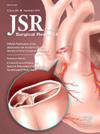烧伤患者的血浆通过不同途径诱导内皮细胞病变
IF 1.7
3区 医学
Q2 SURGERY
引用次数: 0
摘要
导言:内皮损伤对烧伤休克发病机制的影响尚不十分明确。本研究探讨了烧伤患者血浆导致内皮屏障功能失调的潜在机制:方法:从烧伤患者(n = 8)入院 4 小时内采集血浆。方法:收集烧伤患者(8 人)入院 4 小时内的血浆,收集其人口统计学特征和损伤特征,并测量损伤严重程度的标志物,包括国际标准化比率、活化部分凝血活酶时间、辛迪加-1 和白细胞介素 (IL)-6 、IL-1B、IL-10、Il-12p70 以及肿瘤坏死因子-α 的水平。对暴露于烧伤患者血浆或多捐献者血浆(HHP)的人脐静脉内皮细胞单层(HUVEC-m)的通透性(40 kDa 异硫氰酸荧光素(FITC)-葡聚糖扩散)、细胞间隙面积(F-肌动蛋白染色)和细胞凋亡发生率(TUNEL 检测)进行了评估。血浆暴露后,分离 RNA 并将其用于聚合酶链式反应 (PCR) 阵列,靶向与细胞骨架结构或细胞凋亡相关的基因。分析了经 HHP 和烧伤血浆处理的 HUVEC-m 之间的差异:结果:有五种血浆能显著增加 HUVEC-m 的通透性。根据血浆增加通透性的能力对血浆进行分组时,没有观察到年龄、体表总面积百分比、性别、住院死亡率、国际标准化比率、活化部分凝血活酶时间或细胞因子浓度方面的差异;但是,在诱导通透性增加的血浆中,辛迪加-1的水平明显较高。在接触患者血浆后,观察到细胞间隙面积和细胞凋亡以及相关基因表达的增加,但这些指标都与通透性变化的模式或程度不完全相关:烧伤患者血浆会不同程度地破坏 HUVEC-m 的稳态,不同程度地诱导通透性、细胞间隙面积和细胞凋亡的变化。细胞间隙大小和细胞凋亡的增加似乎都不足以解释通透性的变化模式。本文章由计算机程序翻译,如有差异,请以英文原文为准。
Plasmas From Patients With Burn Injury Induce Endotheliopathy Through Different Pathways
Introduction
The contribution of endothelial injury to the pathogenesis of burn shock is not well characterized. This work investigates potential mechanisms underlying dysregulation of endothelial barrier function by burn patient plasmas.
Methods
Plasma was collected from burn-injured patients (n = 8) within 4 h of admission. Demographic and injury characteristics were collected and markers of injury severity including international normalized ratio, activated partial thromboplastin time, and levels of syndecan-1 and interleukin (IL)-6, IL-1B, IL-10, Il-12p70, and tumor necrosis factor-α measured. Human umbilical vein endothelial cell monolayers (HUVEC-m) exposed to either burn patient plasma or multidonor plasma (HHP) were assessed for permeability (40 kDa fluorescein isothiocyanate (FITC)-Dextran diffusion), intercellular gap area (F-actin staining) and incidence of apoptosis (TUNEL assay). Post plasma exposure, RNA was isolated and used in polymerase chain reaction (PCR) arrays targeting genes relevant to cytoskeletal structure or apoptosis. Differences between HHP and burn plasma-treated HUVEC-m were analyzed.
Results
Five plasmas promoted significant increases in HUVEC-m permeability. When plasmas were grouped based on their capacity to increase permeability, no differences in age, %total body surface area, gender, hospital mortality, international normalized ratio, activated partial thromboplastin time, or cytokine concentration were observed; however, significantly higher syndecan-1 levels were seen in the plasmas inducing increased permeability. Increases in intercellular gap area and apoptosis and relevant gene expression were observed after exposure to patient plasmas but none of these metrics correlated completely with the pattern or magnitude of the changes in permeability.
Conclusions
Burn patient plasmas variably disrupt HUVEC-m homeostasis, differentially inducing changes in permeability, intercellular gap area, and apoptosis. Neither increases in intercellular gap size nor apoptosis appear sufficient to explain the pattern of changes in permeability.
求助全文
通过发布文献求助,成功后即可免费获取论文全文。
去求助
来源期刊
CiteScore
3.90
自引率
4.50%
发文量
627
审稿时长
138 days
期刊介绍:
The Journal of Surgical Research: Clinical and Laboratory Investigation publishes original articles concerned with clinical and laboratory investigations relevant to surgical practice and teaching. The journal emphasizes reports of clinical investigations or fundamental research bearing directly on surgical management that will be of general interest to a broad range of surgeons and surgical researchers. The articles presented need not have been the products of surgeons or of surgical laboratories.
The Journal of Surgical Research also features review articles and special articles relating to educational, research, or social issues of interest to the academic surgical community.

 求助内容:
求助内容: 应助结果提醒方式:
应助结果提醒方式:


